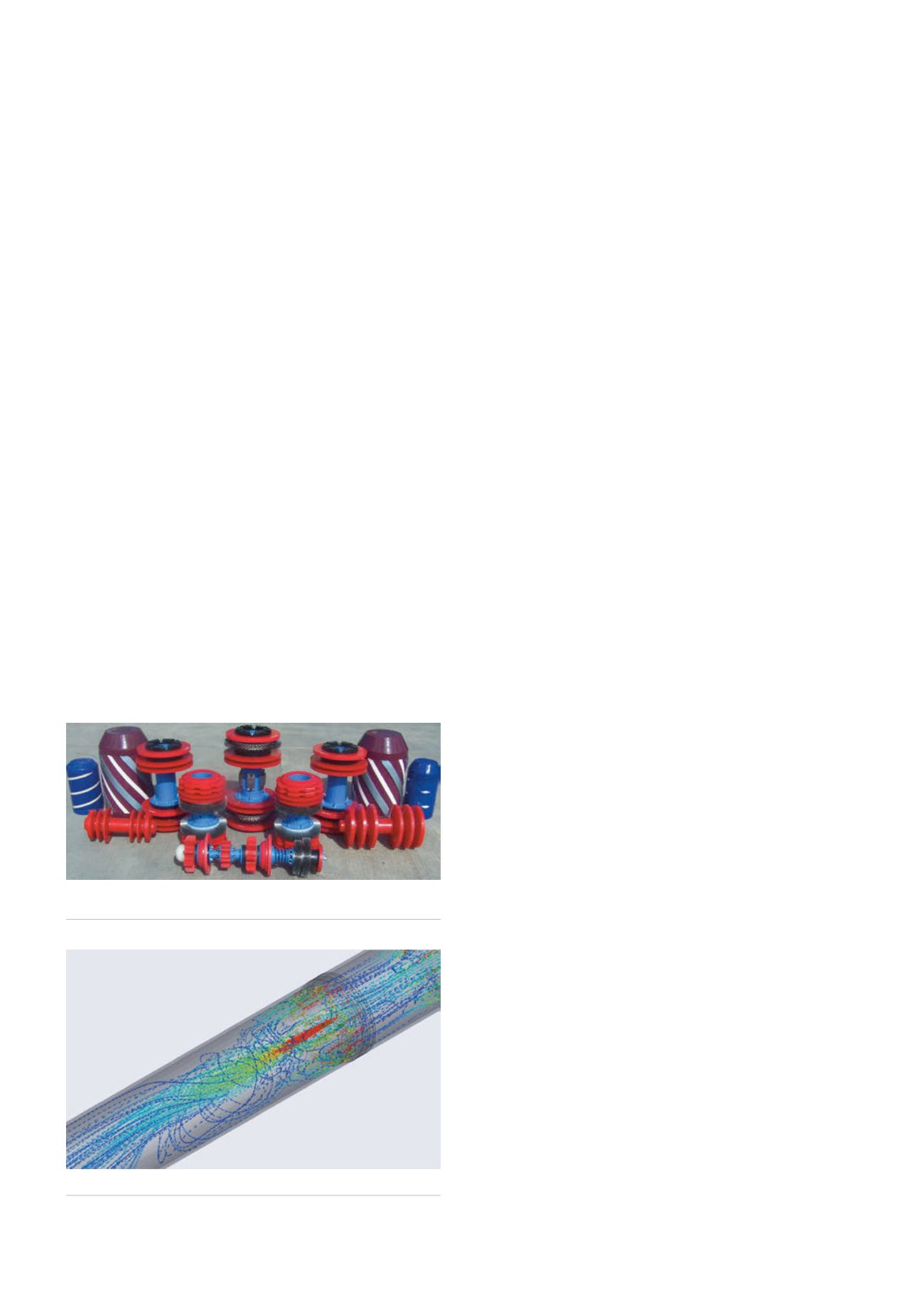
that can be delivered after restarting pigging following
prolonged periods without pigging.
The requirement to return the pipeline to a clean
state is usually driven by a deterioration of the pipeline
hydraulics due to the build-up of debris, or the legal
requirement to perform an inline inspection (ILI) to
confirm the integrity of the pipeline. A lengthy period
without pigging can often be followed by launching a
standard pigging tool into the pipeline. This can result in a
stuck pig, or have a major impact at the receipt facility, if
the quantity of debris in the line is not fully understood.
This is where the progressive cleaning approach should be
employed.
Defining the programme
Broadly speaking, progressive cleaning consists of
the process of incrementally increasing the degree of
cleaning action applied by each successive pipeline pig
in a sequence, in order to control the amount of debris
removed from the pipeline. This control is delivered
by variations in the size and hardness of pigging tool
components. Figure 2 shows some typical examples of
pigging tools with various cleaning mechanisms.
The key to a successful progressive cleaning campaign
lies in understanding the issues to be tackled. A typical
approach is to complete a study, the output of which is a
suite of pig designs and recommendations for progressive
cleaning. In order to arrive at these designs and
recommendations, the study should include a full review
of the pipeline geometry, the pigging history (including
current pig designs used) and the operational conditions
of the pipeline. This is especially relevant for the period
without pigging.
The level of aggression of each pipeline pig in
sequence in the suite of designs will increase to enable
progressive cleaning. However, it is often the case that
the quantity of debris deposition present is not known
with any degree of accuracy. While theoretical models
can give estimates, these calculations are not well
validated. In this situation, a low aggression pig with data
logging capability can be used to verity the predicted
bore restriction. The data that is logged to enable this
is typically the pig differential pressure, acceleration,
vibration and the ambient temperature. This data can
then be fed back into the pigging programme to help
determine what level of aggression should be used to
commence the progressive cleaning. It is good practise
when increasing aggression to alter only one component
at a time on the tool. This enables the impact of the
change to be more easily understood, making the decision
to increase the level more informed. As changes are often
small, polyurethane components can be supplied with
colour coding and dimensions cast into them in order to
help the operation run smoothly.
Computational fluid dynamic (CFD) calculations can
assess the effective use of a bypass through the pigging
tools. It analyses the possible level of fluid bypass
achievable through the pigging tool against the available
flowrates in the line. The process utilises models of
potential pig designs with the flow paths determined,
and tunes them for the best configuration for removal of
debris from both the pipe wall and bore, while keeping
the cleaning elements free from debris. Figure 3 shows a
typical outcome for this type of calculation.
Should there be a requirement for pig development
through testing and verification, prototype pigging
tools would be included in the study in conjunction
with a suitable test rig configuration to cover all of the
pertinent features of the pipeline. The suite of pipeline
pigs can then be tailored through empirical results rather
than relying on theory and experience alone. Testing is
often useful as a way of verifying bypass configurations
determined through CFD analyses. Deposits can be
simulated in the test rig to assess the cleaning capabilities
of the prototype pigs. The output from a testing
programme is a suite of verified pig designs and a pigging
philosophy. Figure 1 illustrates this type of pig proving
work.
The pigging philosophy is a document that should be
used during the progressive cleaning operation to assist
the operators in pig selection throughout the programme.
It will include details of any key assumptions that have
been made in the design so any changes in operational
parameters can be assessed. Specifics of the suite of
pigs with descriptions of the cleaning mechanisms and
anticipated effectiveness will be encompassed. One of
the important aspects of the pigging philosophy will be a
pig run decision tree, included to aid the operators in the
choice of which pig to run next.
Figure 2.
A selection of different types of pigging tools with
various cleaning mechanisms.
Figure 3.
Typical output of CFD calculations.
34
World Pipelines
/
JULY 2015


